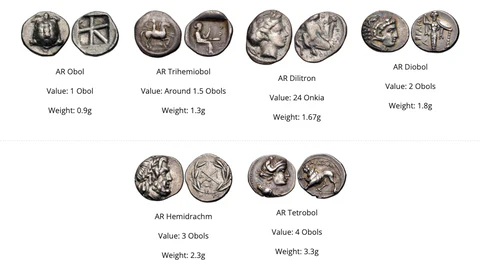Greek Coins: A Collector’s Journey Through History
When I first held an Athenian tetradrachm, I wasn’t just holding a piece of silver—I was holding a piece of ancient history. Ancient Greek coinage like this one were more than money; they were the payroll of sailors, the wages of artisans, and the silent witnesses of philosophical debates. Let me take you through the real, tangible story of Greek coinage—the kind you can feel between your fingers.
The Birth of Greek Coinage: A Revolution You Could Hold
In the 7th century BCE, something revolutionary happened in Lydia (modern-day Turkey). Instead of weighing out blobs of electrum for every transaction, someone had a radical idea: stamp the metal with an official symbol.
What this meant for the Greek world:
-
No more endless haggling over metal purity
-
Recognized, standardized values across city-states
-
Trade exploded like never before
My first Aegina turtle coin told me everything I needed to know:
-
It was heavy and crude—about the size of a half-dollar
-
The sea turtle design wasn’t just decoration—it was Aegina declaring maritime dominance
-
The rough edges still showed where the mint worker had clipped off extra silver by hand
This was the start of something big—an economic and cultural transformation forged in metal.
Classical Greek Coins: When Money Became Masterpieces
By the 5th century BCE, Greek coins had evolved into tiny works of art.
Take the famous Athenian owl tetradrachm. If the Mona Lisa were a coin, this would be it.
-
Athena’s face is rendered in sharp, high relief—you can feel every curve of her helmet
-
The owl on the reverse has feather texture you can detect under your thumb
-
The nearly pure silver content gives it a crisp, musical ring when dropped
Even the wear tells a story. I once found a test cut—an ancient slash to check for counterfeits. That scar told me this coin may have traveled from Athens to Egypt and back, passing through countless hands.
Hellenistic Greek Coins: Kings and Egos in Metal
Then came the Hellenistic era—and with it, the rise of ruler portraits on coins.
Alexander the Great changed the game:
-
His silver tetradrachms were the first to feature realistic royal portraits
-
Minted across vast regions, they circulated long after his death
-
They became so trusted that they remained in use for centuries
One of my favorites? A stunning Ptolemaic tetradrachm of Queen Arsinoe II:
-
Her portrait is hauntingly beautiful
-
The detail on her diadem is so sharp you can count the folds
-
It’s a coin that commands both attention and respect
These were more than coins—they were metallic messengers of power and prestige.
How to Spot Authentic Greek Coins (From Hard Experience)
Like many collectors, I got burned early on. Fakes are everywhere. But now I know what to look for.
✅ Signs of authenticity:
-
The “orange peel” texture of ancient silver
-
Proper weights (e.g., Athenian tetradrachm = ~17.2 grams)
-
Flow lines and die alignment marks from the striking process
❌ Red flags to avoid:
-
Surfaces that are too perfect (real coins have microscopic pits)
-
Sharp or flawless edges (ancient coins were struck, not cast)
-
Bright green patinas—often painted on, not real oxidation
For a full breakdown on spotting counterfeits, check out our Fake Coin Detection Guide.
Why Greek Coins Still Captivate Us
So what makes these coins so irresistible to collectors, historians, and even artists?
-
One drachm might have paid for a lecture by Plato
-
The artistry on some Greek coins rivals museum sculptures
-
Each coin bears the scars of its journey—scratches, cuts, and uneven strikes
My advice to new collectors?
Start small. Get a late Hellenistic bronze. Hold it. Study it. Feel the weight of history in your palm. Then you’ll understand why we chase these metal ghosts of the ancient world.
✅ Final Thought About Ancient Greek Coinage
The next time you see a ancient Greek coinage in a museum case, remember—it wasn’t made to sit behind glass. It was meant to be spent, saved, lost, and eventually rediscovered. Somehow, after millennia, it found its way to us.
If you’re ready to begin your own journey with confidence, start with trusted sources. I personally recommend the British Museum’s ancient Greek coinage Collection for research, and our Ancient Greek Coin Guide for finding authenticated pieces from trusted sellers.
